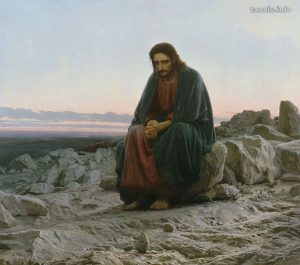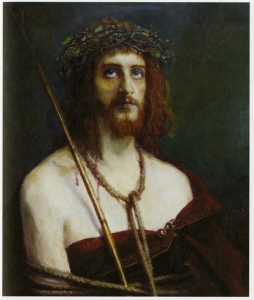Both Ivan Kramskoi and Nikolai Ge’s portraits of Christ combine a traditional, neoclassical subject matter with some additional, more progressive elements, representing the tumultuous, transitioning influences under which both artists were working. Ivan Kramskoi’s famous “Christ in the Dessert” is traditional in the sense that it adheres closely to realist tendencies. The beautiful landscape and Christ’s weathered face and simple, but carefully documented robes are all accurate and detailed and traditional, particularly in their religious subject matter. His weathered and burdened face are of a different era, however, in their emotional and psychological depiction. The deep creases on his face mirror the ridges in the rocks around him, and his coloring echoes and the coloring in the background. He is of the earth. His face is as weathered as the rocks around him and he carries his burden heroically. This painting serves as a combination of a more regal and formal portrait with the natural landscapes that were growing more and more popular at the time. The psychological portrayal of Christ and the beautiful landscape are both more modern and interpretative, while the realistic depiction of Christ is more traditional.

In his second depiction of Christ in “Christ in the Crown of Thorns”, Christ is equally as rugged and his clothing as worn. His eyes are sunken and his hair disheveled and he looks drained and resigned emotionally. His coat and the blood on his neck and the color of his hair are all the same brick red, contrasting starkly with his waxy, pale skin. The wild crown he wears, paired with the noose tied loosely around his neck make him look both threatening and threatened. The realistic depiction of Christ was traditional for the time, but the deep psychological side of it and the wild portrayal is more modern.

Nikolai Ge offers an entirely different interpretation of Christ’s portrait. His thick brush strokes and use of 3 main colors deviate profoundly from art trends at the time. Ge painted many portraits throughout his lifetime, and this one is technically a portrait, but it doesn’t completely glorify the subject. Instead, he depicts Christ looking gaunt and practically dead. The only color he uses is a couple of strokes of red on Christ’s forehead, and the rest of the painting is painted in an eerie green-tinted white. This painting represents the major shift of the artistic trends at the time in its untraditional coloring and stylistic choices and in its nuance portrayal of the subject matter.

